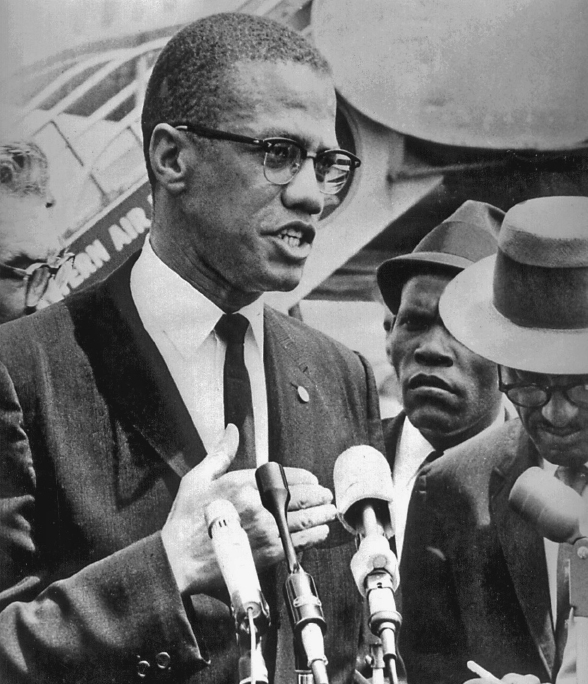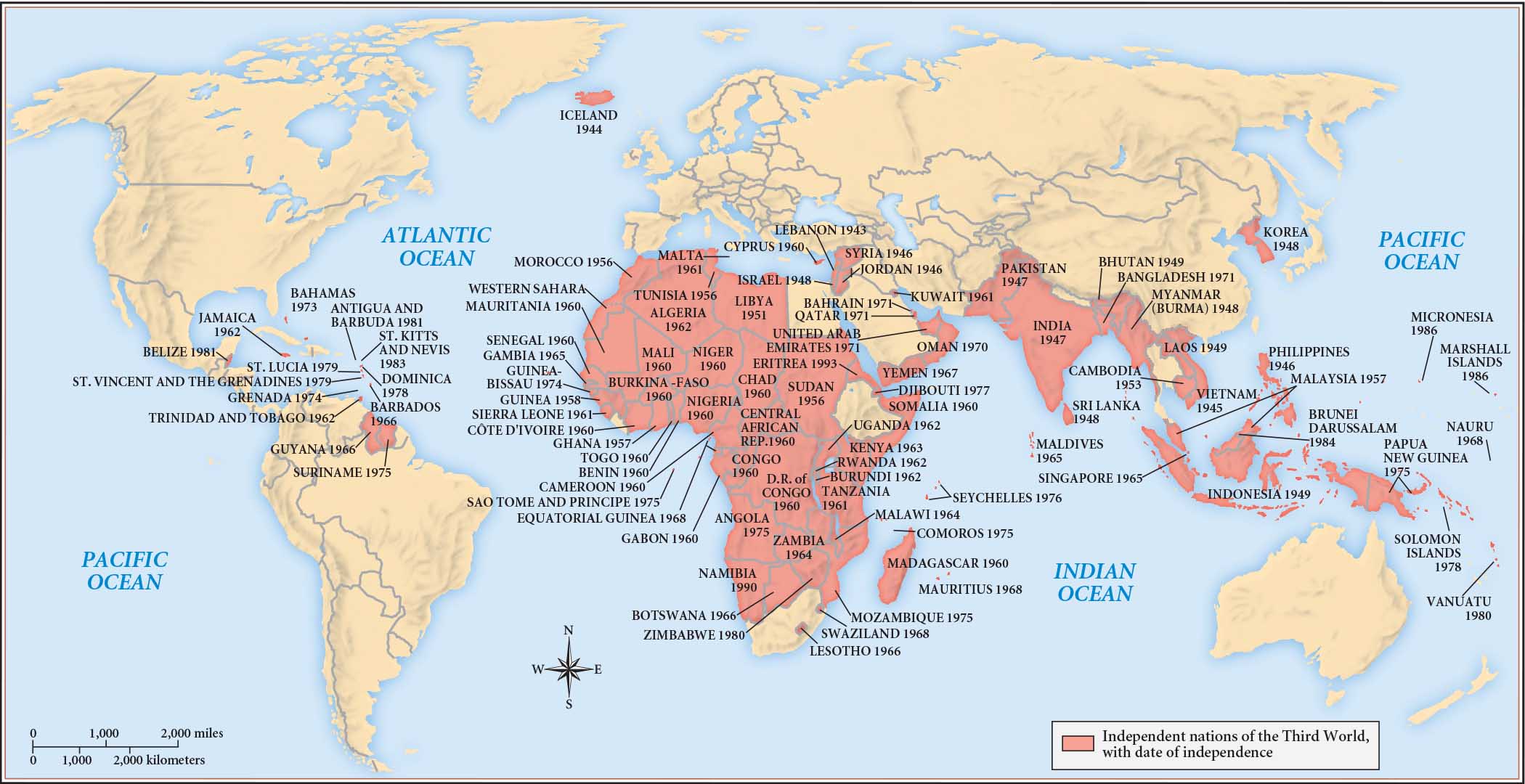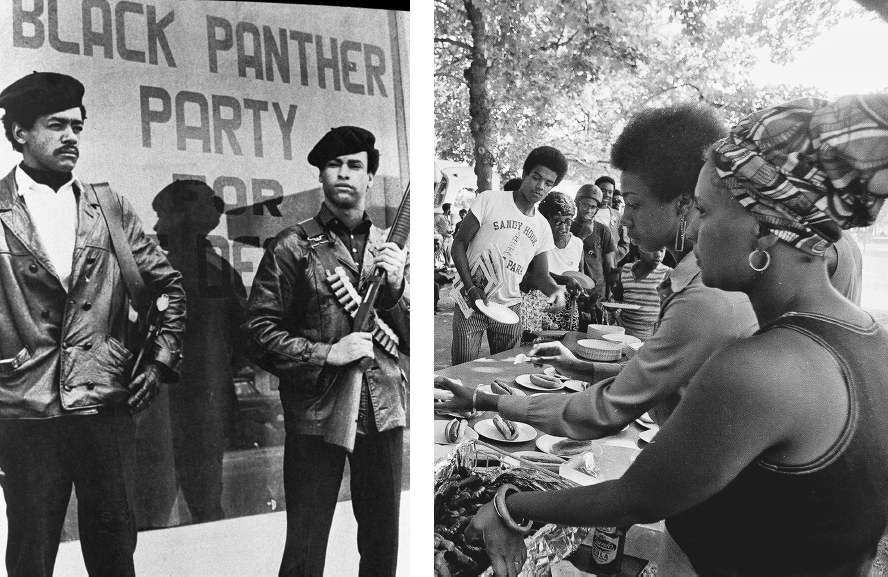America’s History: Printed Page 892
America: A Concise History: Printed Page 810
America’s History: Value Edition: Printed Page 788
Black Nationalism
Seeking answers to these questions led many African Americans to embrace black nationalism. The philosophy of black nationalism signified many things in the 1960s. It could mean anything from pride in one’s community to total separatism, from building African American-owned businesses to wearing dashikis in honor of African traditions. Historically, nationalism had emphasized the differences between blacks and whites as well as black people’s power (and right) to shape their own destiny. In the late nineteenth century, nationalists founded the Back to Africa movement, and in the 1920s the nationalist Marcus Garvey inspired African Americans to take pride in their racial heritage.
In the early 1960s, the leading exponent of black nationalism was the Nation of Islam, which fused a rejection of Christianity with a strong philosophy of self-improvement. Black Muslims, as they were known, adhered to a strict code of personal behavior; men were recognizable by their dark suits, white shirts, and ties, women by their long dresses and head coverings. Black Muslims preached an apocalyptic brand of Islam, anticipating the day when Allah would banish the white “devils” and give the black nation justice. Although its full converts numbered only about ten thousand, the Nation of Islam had a wide popular following among African Americans in northern cities.

Malcolm X The most charismatic Black Muslim was Malcolm X (the X stood for his African family name, lost under slavery). A spellbinding speaker, Malcolm X preached a philosophy of militant separatism, although he advocated violence only for self-defense. Hostile to mainstream civil rights organizations, he caustically referred to the 1963 March on Washington as the “Farce on Washington.” Malcolm X said plainly, “I believe in the brotherhood of man, all men, but I don’t believe in brotherhood with anybody who doesn’t want brotherhood with me.” Malcolm X had little interest in changing the minds of hostile whites. Strengthening the black community, he believed, represented a surer path to freedom and equality.
In 1964, after a power struggle with founder Elijah Muhammad, Malcolm X broke with the Nation of Islam. While he remained a black nationalist, he moderated his antiwhite views and began to talk of a class struggle uniting poor whites and blacks. Following an inspiring trip to the Middle East, where he saw Muslims of all races worshipping together, Malcolm X formed the Organization of Afro-American Unity to promote black pride and to work with traditional civil rights groups. But he got no further. On February 21, 1965, Malcolm X was assassinated while delivering a speech in Harlem. Three Black Muslims were later convicted of his murder.
Black Power A more secular brand of black nationalism emerged in 1966 when SNCC and CORE activists, following the lead of Stokely Carmichael, began to call for black self-reliance under the banner of Black Power. Advocates of Black Power asked fundamental questions: If alliances with whites were necessary to achieve racial justice, as King believed they were, did that make African Americans dependent on the good intentions of whites? If so, could black people trust those good intentions in the long run? Increasingly, those inclined toward Black Power believed that African Americans should build economic and political power in their own communities. Such power would translate into a less dependent relationship with white America. “For once,” Carmichael wrote, “black people are going to use the words they want to use — not the words whites want to hear.”
Spurred by the Black Power slogan, African American activists turned their attention to the poverty and social injustice faced by so many black people. President Johnson had declared the War on Poverty, and black organizers joined, setting up day care centers, running community job training programs, and working to improve housing and health care in urban neighborhoods. In major cities such as Philadelphia, New York, Chicago, and Pittsburgh, activists sought to open jobs in police and fire departments and in construction and transportation to black workers, who had been excluded from these occupations for decades. Others worked to end police harassment — a major problem in urban black communities — and to help black entrepreneurs to receive small-business loans. CORE leader Floyd McKissick explained, “Black Power is not Black Supremacy; it is a united Black Voice reflecting racial pride.”
The attention to racial pride led some African Americans to reject white society and to pursue more authentic cultural forms. In addition to focusing on economic disadvantage, Black Power emphasized black pride and self-determination. Those subscribing to these beliefs wore African clothing, chose natural hairstyles, and celebrated black history, art, and literature. The Black Arts movement thrived, and musical tastes shifted from the crossover sounds of Motown to the soul music of Philadelphia, Memphis, and Chicago.
Black Panther Party One of the most radical nationalist groups was the Black Panther Party, founded in Oakland, California, in 1966 by two college students, Huey Newton and Bobby Seale. A militant organization dedicated to protecting African Americans from police violence, the Panthers took their cue from the slain Malcolm X. They vehemently opposed the Vietnam War and declared their affinity for Third World revolutionary movements and armed struggle (Map 27.5). In their manifesto, “What We Want, What We Believe,” the Panthers outlined their Ten Point Program for black liberation.

The Panthers’ organization spread to other cities in the late 1960s, where members undertook a wide range of community-organizing projects. Their free breakfast program for children and their testing program for sickle-cell anemia, an inherited disease with a high incidence among African Americans, were especially popular. However, the Panthers’ radicalism and belief in armed self-defense resulted in violent clashes with police. Newton was charged with murdering a police officer, several Panthers were killed by police, and dozens went to prison. Moreover, under its domestic counterintelligence program, the Federal Bureau of Investigation (FBI) had begun disrupting party activities.
Young Lords Among those inspired by the Black Panthers were Puerto Ricans in New York. Their vehicle was the Young Lords Organization (YLO), later renamed the Young Lords Party. Like the Black Panthers, YLO activists sought self-determination for Puerto Ricans, both those in the United States and those on the island in the Caribbean. In practical terms, the YLO focused on improving neighborhood conditions: city garbage collection was notoriously poor in East Harlem, where most Puerto Ricans lived, and slumlords had allowed the housing to become squalid. Women in the YLO were especially active, protesting sterilization campaigns against Puerto Rican women and fighting to improve access to health care. As was true of so many nationalist groups, immediate victories for the YLO were few, but their dedicated community organizing produced a generation of leaders (many of whom later went into politics) and awakened community consciousness.

The New Urban Politics Black Power also inspired African Americans to work within the political system. By the mid-1960s, black residents neared 50 percent of the population in several major American cities — such as Atlanta, Cleveland, Detroit, and Washington, D.C. Black Power in these cities was not abstract; it counted in real votes. Residents of Gary, Indiana, and Cleveland, Ohio, elected the first black mayors of large cities in 1967. Richard Hatcher in Gary and Carl Stokes in Cleveland helped forge a new urban politics in the United States. Their campaign teams registered thousands of black voters and made alliances with enough whites to create a working majority. Many saw Stokes’s victory, in particular, as heralding a new day. As one of Stokes’s campaign staffers said: “If Carl Stokes could run for mayor in the eighth largest city in America, then maybe who knows. We could be senators. We could be anything we wanted.”
Having met with some political success, black leaders gathered in Gary for the 1972 National Black Political Convention. In a meeting that brought together radicals, liberals, and centrists, debate centered on whether to form a third political party. Hatcher recalled that many in attendance believed that “there was going to be a black third party.” In the end, however, delegates decided to “give the Democratic Party one more chance.” Instead of creating a third party, the convention issued the National Black Political Agenda, which included calls for community control of schools in black neighborhoods, national health insurance, and the elimination of the death penalty.
Democrats failed to enact the National Black Political Agenda, but African Americans were increasingly integrated into American political institutions. By the end of the century, black elected officials had become commonplace in major American cities. There were forty-seven African American big-city mayors by the 1990s, and blacks had led most of the nation’s most prominent cities: Atlanta, Chicago, Detroit, Los Angeles, New York, Philadelphia, and Washington, D.C. These politicians had translated black power not into a wholesale rejection of white society but into a revitalized liberalism that would remain an indelible feature of urban politics for the rest of the century.
UNDERSTAND POINTS OF VIEW
Question
Why were Black Power and black nationalism compelling to many African Americans?